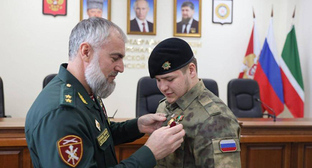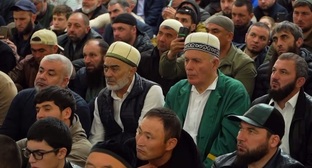12 January 2004, 14:29
Introduction. The Caucasus-Native Land of the Vainakhs. Land and people
The Caucasus is one of the largest geographical and historical-cultural regions of Front Asia. The Caucasus is washed by the Black Sea and the Sea of Azof in the west and by the Caspian Sea in the east that makes it the isthmus between Europe and Asia. The northern geographical boundary of the region - the Kuma-Manich depression, starts out of the Lower Don and descends into the lower reaches of the river Kuma.The southern frontier is drawn by the boundary line of the former Soviet Union, and today it passes between the independent States of Georgia, Armenia, Azerbaijan, and Turkey and Iran. The southern boundary of the Caucasus, however, is very relative, as neither of its sides has any natural distinction. This boundary does not correspond to the historical and ethnographical realities either. The southern boundary in the present sense appeared only in 1921. Within the aforementioned bounds the Caucasus covers an area of close to 450,000 sq km.
Although there are several hypotheses, the origin of the term "Caucasus" can not be considered finally established. However, the ethnicon is very old. It is mentioned in historical sources of the 6th - 5th centuries B.C. that have come down to us, namely, in writings of Aeschylus and Herodotus. It is worthy of remark that ancient Greeks named Caucasus not only the mountain ridge, where Prometheus was chained to a solitary rock, but also the area of lower front ranges, lofty spurs and intermontane plains. As to the tribes inhabiting this land, they were collectively referred to as "Caucasians". Hence it appears that the notion of the Caucasus in the sense of a definite geographical region with the polylingual population, but close by culture and origin, came into existence as early as the ancient epoch.
The central part of the Caucasus is occupied by the mountain system of the Great Caucasus. Its constituents are the Main, or Watershed, and Lateral ranges with peaks rising more than 5000 m above sea level. The highest peak of the Caucasus is Mt. Elbrus (5642 m). The main Watershed divides the region into two parts: the Northern Caucasus and the Southern Caucasus, or Transcaucasia(1). North and south of the Main and Lateral Ridges stretch lower front mountain chains. The parallel ranges of the Great Caucasus are connected with the transversal mountain ridges, forming a number of more or less spacious intermontane hollows.
Longwise (up to 1100 km) the Great Caucasus is divided into three parts: The Western, Eastern and Central Caucasus. The sections running through the mountains Elbrus and Kazbek fix the boundaries between them. The highest peaks of this mountainous country are in the Central Caucasus, including the Elbrus, Dikhtau (5203 m), Kashtantau (5145 m), Shkhara (5058 m), Tangitau (5051 m), Kazbek (5047 m).
Most of the peaks of the Main, Lateral and other ranges of the Great Caucasus are covered with eternal snow and glaciers. The lower border of eternal snow cover (a snow line) raises here owing to extending of dry climate from west to east. On the slopes of the Western Caucasus the snow line reaches 2900 - 3000 m, within the limits of the Central Caucasus it raises to 3200 m, as to the Eastern Caucasus, the snow - covered region here is at a height of 3700 - 3800 m.
In the south of Transcaucasia rises mountainous region of the Transcaucasian Upland reaching a height of 4090 m (the town of Aragats). In the north and north - west it is fringed by the Lesser Caucasus Range (nearly 3724 m, town of Gamish). The northern border of the Lesser Caucasus is formed of the valleys of the Rioni and Mtkvari rivers, in the south it borders on the river Araxes, between the mountain massifs of the Great and Lesser Caucasus, on the territory of Georgia, lies the Likhi Range dividing the country into the western and eastern parts.
In the Caucasus there are also a number of vast lowlands and foothill regions, including the Colchis Lowland, the Kartli Plain, the Mtkvari-Araxes Lowland, etc. As regards the North Caucasus, a considerable part of the area is covered with the steppes, forming the threshold of vast Europe-Asian plains.
Main rivers of the Caucasus (from west to east) are the Kuma, Terek, Sulak, Samur, Mtkvari and Araxes rivers falling into the Caspian Sea, and the Eya, Kuban, Inguri, Rioni, Chorokhi rivers, draining into the Black Sea and Azof basin. The largest of them, the Mtkvari (Kura) takes its source in Turkey, but mainly flows on the territories of Georgia and Azerbaijan. The Mtkvari is 1364 km long, the basin area is 188,000 sq km. The largest rivers of the North Caucasus are the Kuban (870 km long) and Terek (623 km long).
The largest lake in the Caucasus is Lake Sevan (in Armenia), of course, not counting the Caspian Sea - the largest reservoir on the Earth, surrounding the isthmus in the east.
As regards the climate of the region, the Caucasus is located at the junction of temperate and subtropical zones. The climate in the North Caucasus, viewed as a whole, is assumed to be temperate, whereas the South Caucasus is attributed to the subtropical zone. The Caucasus Range serves as a border between them forming an obstacle to the cold arctic masses of air to move to the south and, vice versa, detaining the streams of warm air to extend from the south to the north. However, it is impossible to reflect the whole of the diversity of climatic peculiarities characteristic to separate regions of the Caucasus. In Transcaucasia, for example, the damp subtropical climate of Colchis and the territory adjacent to the Caspian Sea in the southwest is combined with the continental-cold and mountainous-cold climate of highlands.
Hence it appears that diversity of the nature makes the Caucasus a region of striking contrasts, where the high-mountain glaciers and steppe plains, dense forests and bare rocks, the subtropics suffused with moisture, and semi-deserts dried up in the blazing sun are in the immediate vicinity.
Taking into consideration the economic activities of the population, lowlands and foothills are of much more significance than mountains: they are densely populated, well-developed for growing crops and have advantageous transport locations. Gas and oil, the major natural resources of the Caucasus, are extracted in the lowlands and foothills of the region. Besides, the entrails of the earth in this region are rich of deposits of polymetallic and manganese ores, building materials, coal - fields, and medicinal mineral springs.
* * *The Caucasus is notable for diversity of nationalities and multiplicity of languages, that is conditioned by the peculiarities of the historical development and natural conditions of the region. Not without reason was it called "a Mountain of Languages" by the medieval Arabs: the representatives of about 50 nationalities, speaking independent languages, are the inhabitants of this land. From the linguistic point of view these languages mainly belong to three lingual families: Caucasian proper, or Paleocaucasian, Indo-European and Altaian.
The Caucasian family is divided into three groups: Western, i.e., Adygei - Abkhazian, Eastern, i.e.,Vainakh-Daghestanian and Southern, i.e., Kartvelian.The representatives of the Caucasian family are the ancient inhabitants of the Caucasus (this accounts for the term "paleocaucasian"), related to each other by common origin(2). The western group consists of two subgroups: the Adygei and Abkhazian - Abazian branches. The Adygeis, or Circassians, one of the most numerous and far - famed peoples of the Caucasus, still densely populated a vast territory from the Black Sea coast to the Middle Terek as far back as the first half of the 19th century. At present they settle this area, scattered about in groups. In Soviet ethnicon nomenclature the Adygei ethnic group is represented as the Kabardinians (391,000)(3), inhabiting the territory of the Terek River basin, the Circassians (52,000), living in the area of the Upper Kuban, and the Adygeis (125,000) populating that of the Lower Kuban and the territory adjacent to the Black Sea. However, the Adygei peoples clearly realize their ethnic unity and call themselves their common name - Adygei
The area of settling of the Abkhazians (105,000) and Abazians (34,000) is also cut off against last century. The reduction of the ethnic territory of the Adygei - Abkhazians in the 19th century was caused by mass migration of these peoples to the Ottoman Empire after the conquest of the Caucasus by Russia. It resulted in devastation of a good deal of territory formerly settled by the tribes of the West-Caucasian group. Later the region was occupied by the other peoples. The descendants of the Caucasian migrants live in the countries of the Near East (Turkey, Syria, Jordan, Iraq and others). According to different data the Adygei-Abkhazian diaspora in the Near East numbers from one to several million people.
The eastern branch of the Caucasian languages also divides into two subgroups: the Vainakh and Daghestan branches. The Vainakhs, as is generally known, is a collective name of the Chechens and Ingushes. This linguistic community also includes the Batsbi, i.e., Tsova-Tushetians, a not numerous ethnographic group, living in the north-west of Georgia. The Batsbi consider themselves to be Georgians, though they speak their native language, similar to the dialects of the highlanders of Chechnya and Ingushetia. According to the general census of the population, they are not referred to as a separate nation.
The languages of the Daghestan subgroup are spoken by numerous peoples of the Daghestan Upland and, partly, that of the provinces contiguous to Azerbaijan. The most numerous of them are the Avars (601,000), Lezghins (466,000), Darghins (365,000), Laks (118,000), Tabasarans (98,000), as well as Rutuls (20,000), Tsakhurs (20,000) and Aghuls (19,000). Some of the Daghestan ethnographic groups having their own local spoken dialects, different from that of their neighbours, number several hundred to several thousand people and are the inhabitants of only one or a few villages. Today they mainly consolidate with the more numerous Daghestan peoples and according to the general census are not marked as separate nationalities, though in a large measure preserve their identity. Thus, for example, are the Andians, Botliks, Godoberins, Chamalals, Baghulals, Tindals, Karatinians, Akhvakhs, Tsezes, Ghinukhians, Khvarshins, Bezhtins, Gunzibs, Archins associated with the Avars, the most numerous Daghestan people. The Kaytags and Kubachins are consolidated with the Darghins.
Some of the Daghestan peoples partly live on the territory of Azerbaijan as well, including the Lezghins, Avars and Tsakhurs. Besides them, the Udins (8,000) and not numerous peoples of the so-called "Shakhdag group"(4) - the Budughes, Kriz, Khinalughes live in Azerbaijan. They are the descendants of the ancient population of Eastern Transcaucasia, speaking the languages of Daghestan subgroup of the Vainakh-Daghestan group of peoples.
The southern (Kartvelian) branch of the Caucasian family is represented by the Georgians (3,981,000) - the main population of the Republic of Georgia. The Georgians are divided into a number of subethnic groups, some of which (Megrelians, Svans) have retained their own spoken dialects, closely related to the Georgian language. The Kartvelian languages are partly spoken in the north-eastern part of Turkey, where the people speaking this language inhabited quite a sizeable part of its territory in the past. Georgian is the only ancient written language of all the living Caucasian languages (literary monuments of the 5th century A.D.).
It should be noted that the area of spread of the Palaeocaucasian languages gradually grew narrower for the space of epochs. Several millenia ago the tribes speaking the Caucasian languages apparently inhabited not only the whole Caucasus (or the most of its part), but also the areas far out of its limits. According to some scientists, certain nations of the Ancient East, including the Guthis, Khats (Protokhets), Kasks, Khurrits, Urarts and others, were ethnically close to different branches of the Palaeocaucasian family. Proceed from this, the Palaeocaucasians, i.e., aborigenes of the places of settlement of alien tribes, took part in ethnogeny of the majority of peoples inhabiting the Caucasus today and speaking the languages of Indo - European and Turkic system. This is also confirmed by anthropological data.
It is interesting to note that an opinion of the Caucasian unity, based on the community of origin, came into existence in the Caucasus very long ago. Leonti Mroveli, a prominent Georgian author of the 11th century, begins his work on the history of ancient Georgia with the mythical times of the Caucasus and gives a genealogical "tree" of the Caucasus peoples, representing the Armenians, Georgians, Vainakhs, Daghestan tribes and others, as the descendents of legendary Targamos - their common ancestor. According to Mroveli the descendents of Targamos, inhabiting all over the Caucasus, lived in friendship and came out together against the outer enemies to defend their native land.
Long before our era the first Indo - Europeans began to penetrate in the Caucasus. As a result of complicated assimilation processes part of new comers mixed with the local tribes. As to the other part, having trasferred their language to the indigenous population, they became the constituent of the eventually formed Indo-European peoples of the Caucasus. Of them Armenians are the most numerous (4623,000). Ancient Armenia had stretched on a vast area of Front Asia, though in the 20th century only the territory of the Southern Caucasus (historical East Armenia) was left as a base of ethnical development and statehood of the Armenian people. There is also a numerous Armenian diaspora scattered over the world.
Some of the Caucasian peoples belong to the Iranian branch of the Indo-European family. The ancient Iranians came to the Caucasus both from the Euro-Asian steppes, in the north, and the Iranian Upland, in the south. Their descendents in the North Caucasus are the Ossets (598,000), partly living in Georgia as well, and the Tatts (31,000) and Talishes (22,000) in Azerbaijan. A part of the inhabitants in the South Caucasus also consists of the Kurds who speak Iranian, though the bulk of this nation live in their historical homeland outside the Caucasus.
The same can be said about the Greeks who came to the Caucasus mainly in the 18th -19th centuries and are not directly related with the ancient Greek colonists of the Eastern Black Sea area.
And lastly, the most numerous group of Indo-Europeans in the Caucasus today are the Slavs, mainly Russians (first Cossack settlements, 14th century), as well as the Ukrainians (end of the 18th century)(5). They inhabit almost all regions of the Caucasus, but more compactly they are settled in Krasnodar and Stavropol Territories of the Russian Federation, making up 90 per cent of the total population.
The Altaian family in the Caucasus is mainly represented by the Turkic branch. The first Turks appeared in the Caucasus during the invasion of the Huns (4th century). Afterwards the nomad Turkic tribes repeatedly invaded the Caucasus, both from the northern steppes, and from the south, and settled in different parts of the region. As far back as the early Middle Ages substantial groups of Turkic population had been formed in the North Caucasus, who, as a result of ethnogenetic processes with the participation of local tribes as well as new Turkic tribal unions, appearing in the Front Caucasus (particularly the Kipchaks from the 11th century), formed a Kumyik and Karachai-Balkarian community. The Kumyiks (282,000) inhabit the plains of Daghestan, as for the Karachais (156,000) and Balkarians (85,000), they are settled in the area of the Great Caucasus, in the vicinity of the Mt.Elbrus.
The Nogais (75,000) are the only Turkic speaking people of the Caucasus formed as ethnopolitical community (union of tribes) outside its borders. They are the descendents of Turkic-Mongolian nomadic tribes, settled on the territory between the Caspian and Azof Seas in the 15th century. Here the Nogais have developed into the nation living at present as separate enclaves from Kuban to the Caspian Sea.
The most numerous Turkic speaking people of the Caucasus are the Azerbaijanis (6,770,000). Nearly 15 million representatives of this nation live in Iran, and in so-called Iranian, or South Azerbaijan. In ethnogeny of the Azeirbaijanis a definitive importance is attached to the ancient local tribes of the East Caucasus and North-Western Iran, who later mixed with the Turkics newcomers having transferred to the latters their native tongue (especially from the 11th -13th centuries).
The so-called "Meskhetian Turks" is also considered a Turkic speaking ethnic group. Great bulks of them are the descendents of one part of the Meskhis, a Georgian tribe, Islamized and Turkized during the Turkish rule in the 18th-19th centuries. The Meskhis, deported from Meskheti (Southern Georgia) in 1944, inhabit in separate groups in the states of Central Asia, Russia and Azerbaijan. A small number of these people live in Georgia as well, though the problem of repatriation of the Meskhis to their native land has not been settled so far.
In the outlying districts northward of the North Caucasus inhabit the Turkic - speaking Trukhmens, part of Central Asian Turkmens who moved over the North Caucasus in the 17th or 18th centuries, as well as a small group of the Kalmyks (17th century), a nation of Mongolian origin, though the Kalmyks mainly populate the area from the steppe districts in the North of the Caucasus to the river Volga.
In addition to the afore-named nations several groups of Semitic origin have been living in the Caucasus since olden times. Particular attention should be given to the local Jews who, for centuries of their residence in the Caucasus, have forgotten their own tongue and use the language of the local population as their native language: In Georgia they speak Georgian, in Daghestan and Azerbaijan they speak Tattish, etc...
* * *Anthropologically the natives of the Caucasus, with the exception of the Nogais who have the characteristic Mongoloid features, belong to the southern branch of the European race, out of which the following are the four principal types:
TheCaucasian type is spread in the regions of the Great Caucasus, on both sides of the range. People of this type are of large stature, broad-faced, the colour of eyes and hair with a considerable touch of light tints (though prevail the dark-haired), round-headed.
The Caucasian type is prevalent with the Karachais, Balkarians, Ossets, Vainakhs, Western Daghestans and the mountaineer Georgians (Svans, Mokhevis, Khevsurs and others).
ThePontian type is on the whole similar to the Caucasian one, though the former is characterized by less broad face and other distinctive features. The Pontian type is prevalent with the Adygeis; there is an evidence of its influence with the Abkhazs and Western Georgians (inhabitants of the Colchis Lowland). As for the Kabardians, Circassians and Abazians, they are considered to be intermediate of the characteristic representatives of the Caucasian and Pontian Types.
The Caspian type is characterized by the darkest pigmentation of hair, eyes, and skin. People of this type are of medium height and narrow-faced. The Caspian type is spread with the Azerbaijanians, Tatts, Talishes, and Kurds. In Daghestan it is prevalent with the Kumyiks.
The Front Asiatic type is characteristic to the Armenians, and to some extent to the eastern and southern Georgians (the Kartlis, Meskhis, Javakhis). Owing to a number of distinctions this type is regarded as intermediate of the Caucasian and Caspian types. The analogues of the last three types are found among the inhabitants of the Mediterranean area and Front Asia. As regards the Caucasian type, it is met nowhere but in the Caucasus. As a matter of fact, there are no sharp distinctions among the mentioned anthropological types.
* * *Due to its location at the junction of the East and West, the Caucasus always was under the political and cultural influence of both of these worlds. It is also evinced in religious composition of the population. Christianity (from the very first centuries of our era) and Islam (7th - 8th centuries) have been introduced here on a large scale. Besides the representatives of the Eastern Slav peoples the great bulk of Georgians, majority of Ossets, almost half of Abkhazs and a small group of Kabardians are Orthodox Christians. The overwhelming majority of the Armenians are Christian-monophysites, the folowers of the Armenian-Gregorian Church. There are also not great communities of Georgian and Armenian Catholics.
Islam of Sunnite orientation is confessed by the majority of native peoples of the North Caucasus, the Muslim Georgians (the Adjars and others), as well as part of Abkhazs, Ossets and Azerbaijanians. The bulk of Azerbaijanians and a small part of the Lezghins are Shia Muslims. The Caucasian Jews confess Judaism, as to the Kalmyks, they are Buddhists.
At the same time, a certain part of the indigenous population of the Caucasus, including the Abkhazs, Ossets, Ingushes, the mountaineer Georgians, etc., has retained the survivals of paganism, which turned out to be irreplaceable either by Christianity or Islam, but adopted, having been slightly modified.
Despite such diversity of confessions (or perhaps, partly, thanks to this fact), religious fanaticism and intolerance are alien to the Caucasus. Dissensions between the nations, unfortunately, taking place in certain parts of the region, bear no relation to religious factor but are caused by social and political reasons, arisen as recently as the 19th - 20th centuries.
Notes
(1) In Geographical literature the Caucasus sometimes is devided into three main regions: the Front Caucasus, the Great Caucasus and Transcaucasia.
(2) Some scientists consider that only the Adygei - Abkhazian and Vainakh - Daghestan languages are genetically related languages and unite them in so - called North - Caucasian family, whereas the Kartvelian group is attributed to the special system. The similarity of the North - Caucasian and Kartvelian languages is a result of the contacts established in ancient times. Thus, according to these scientists, in the Caucasus there are two native, but not related families of the languages - the North - Caucasian and the Kartvelian ones.
(3) Here and further in brackets is given the number of the mentioned nation in the USSR according to the 1989 census.
(4) The settlements of this group are in the environs of Mt. Shakhdag, hence the name "Shakhdag group".
(5) The first penetration of the Eastern Slavs in the North Caucasus dates back to the 10th - 11th centuries when a small Russian principality existed in the area adjacent to the Kerch Strait, separating the Caucasus from the Crimea. However, towards the beginning of the 12th century it was annihilated leaving no noticeable trace in the ethnopolitical and cultural development of the Caucasus.





Комментирование через Кавказский узел